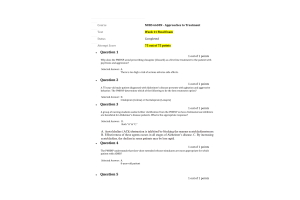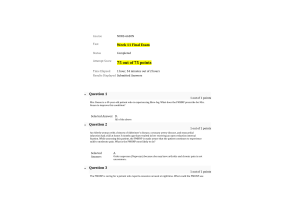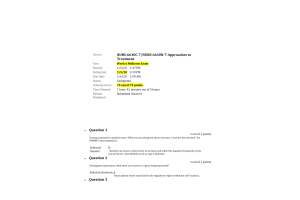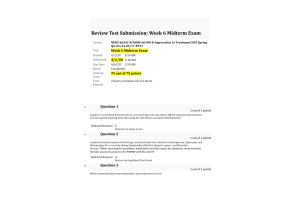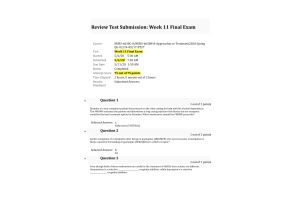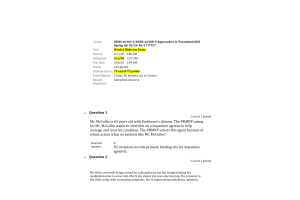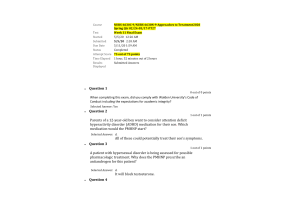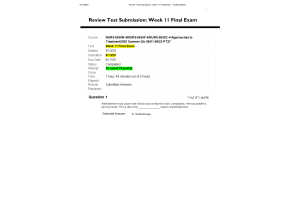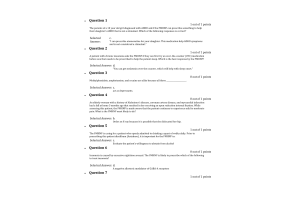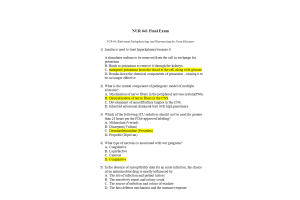NURS 6630C-6, NURS 6630N-6; Exam - Week 11 Final (75 out of 75 Points)
- $49.00
NURS 6630 Psychopharmacologic Approaches to Treatment of Psychopathology
- Question: A 75-year-old male patient diagnosed with Alzheimer’s disease presents with agitation and aggressive behavior. The PMHNP determines which of the following to be the best treatment option?
- Question: All drugs that lead to addiction increase __________________in the ventral striatum, which is also called the _______________.
- Question: The PMHNP is attempting to treat a patient’s chronic pain by having the agent bind the open channel conformation of VSCCs to block those channels with a “use-dependent” form of inhibition. Which agent will the PMHNP most likely select?
- Question: A patient addicted to heroin is receiving treatment for detoxification. He begins to experience autonomic hyperactivity during the drug withdrawal period. What medication will the PMHNP prescribe for this patient?
- Question: A patient with chronic insomnia asks the PMHNP if they can first try an over-the-counter (OTC) medication before one that needs to be prescribed to help the patient sleep. Which is the best response by the PMHNP?
- Question: Antipsychotics are doses at a level that blocks ________% of D2 receptors.
- Question: A 26-year-old female patient with nicotine dependence and a history of anxiety presents with symptoms of attention deficit hyperactivity disorder (ADHD). Based on the assessment, what does the PMHNP consider?
- Question: Sandra complains of constipation after being on quetiapine (SEROQUEL) for several weeks. Constipation is likely caused by the binding of quetiapine (SEROQUEL) to which receptor?
- Question: Karen completes the Epworth sleepiness scale and scores abnormally high. She is diagnosed with narcolepsy. The PMHNP prescribes a wake-promoting agent that is a weak dopamine transporter antagonist. Which medication did the PMHNP prescribe?
- Question: The PMHNP wants to prescribe Mr. Barber a mood stabilizer that will target aggressive and impulsive symptoms by decreasing dopaminergic neurotransmission. Which mood stabilizer will the PMHNP select?
- Question: Which patient will receive a lower dose of guanfacine?
- Question: Neal is complaining of restless leg syndrome and insomnia. Which first-line medication should the PMHNP prescribe to treat both?
- Question: The PMHNP prescribes pregabalin (LYRICA) for a patient with chronic pain. How does pregabalin work to reduce pain?
- Question: A patient on chronic opioids is currently on oxycodone ER (OxyContin). The PMHNP is consulted to treat underlying depression. Under which circumstance should the PMHNP order naloxone (NARCAN)?
- Question: An opioid-naive patient is taking MS Contin (morphine sulfate) to treat his pain that is secondary to cancer. Under what circumstances would the PMHNP order naloxone (Narcan) IM/SQ?
- Question: Which statement best describes a pharmacological approach to treating patients for impulsive aggression?
- Question: Alcohol enhances inhibition at ____________ synapses and reduces excitation at ______________ synapses.
- Question: A patient with gambling disorder and no other psychiatric comorbidities is being treated with pharmacological agents. Which drug is the PMHNP most likely to prescribe?
- Question: Harold complains of pain associated with his irritable bowel syndrome with constipation. The PMHNP decides to prescribe a medication that prevents pain signals from reaching the brain. Which agent does the PMHNP prescribe?
- Question: The PMHNP understands that bupropion (Wellbutrin) is an effective way to assist patients with smoking cessation. Why is this medication effective for these patients?
- Question: A patient with irritable bowel syndrome reports chronic stomach pain. The PMHNP wants to prescribe the patient an agent that will cause irrelevant nociceptive inputs from the pain to be ignored and no longer perceived as painful. Which drug will the PMHNP prescribe?
- Question: Naltrexone (Revia), an opioid antagonist, is a medication that is used for which of the following conditions?
- Question: A patient with chronic back pain has been prescribed a serotonin-norepinephrine reuptake inhibitor (SNRI). How does the PMHNP describe the action of SNRIs on the inhibition of pain to the patient?
- Question: Methylphenidate, amphetamine, and cocaine are alike because all three _____________________.
- Question: An interneuron is a neuron that has its cell body, dendrites, and axon within the spinal cord. The neuron can be considered excitatory if it contains ____________ or inhibitory if it contains ____________.
- Question: Which of these characteristics does NOT meet the criteria for probably Alzheimer's dementia?
- Question: An 80-year-old female patient diagnosed with Stage II Alzheimer’s has a history of irritable bowel syndrome. Which cholinergic drug may be the best choice for treatment given the patient’s gastrointestinal problems?
- Question: The PMHNP is meeting with the parents of an 8-year-old patient who is receiving an initial prescription for D-amphetamine. The PMHNP demonstrates appropriate prescribing practices when she prescribes the following dose:
- Question: The PMHNP is assessing a patient who has expressed suicidal intent and is now stating that he is hearing voices and sees people chasing him. The PMHNP identifies these symptoms to be associated with which of the following?
- Question: The PMHNP is attempting to treat a patient’s chronic insomnia and wishes to start with an initial prescription that has a half-life of approximately 1–2 hours. What is the most appropriate prescription for the PMHNP to make?
- Question: The PMHNP is treating a patient for fibromyalgia and is considering prescribing milnacipran (Savella). When prescribing this medication, which action is the PMHNP likely to choose?
- Question: Mr. Peterson is meeting with the PMHNP to discuss healthier dietary habits. With a BMI of 33, Mr. Peterson is obese and needs to modify his food intake. “Sometimes I think I’m addicted to food the way some people are addicted to drugs,” he says. Which statement best describes the neurobiological parallels between food and drug addiction?
- Question: The PMHNP is caring for a patient who experiences too much overstimulation and anxiety during daytime hours. The patient agrees to a pharmacological treatment but states, “I don’t want to feel sedated or drowsy from the medicine.” Which decision made by the PMHNP demonstrates proper knowledge of this patient’s symptoms and appropriate treatment options?
- Question: The PMHNP is teaching a patient with a sleep disorder about taking diphenhydramine (Benadryl). The patient is concerned about the side effects of the drug. What can the PMHNP teach the patient about this treatment approach?
- Question: The PMHNP is assessing a patient who presents with elevated levels of brain amyloid as noted by positron emission tomography (PET). What other factors will the PMHNP consider before prescribing medication for this patient, and what medication would the PMHNP want to avoid given these other factors?
- Question: Mrs. Kenner is concerned that her teenage daughter spends too much time on the Internet. She inquires about possible treatments for her daughter’s addiction. Which response by the PMHNP demonstrates understanding of pharmacologic approaches for compulsive disorders?
- Question: The PMHNP is caring for a patient with chronic insomnia who would benefit from taking hypnotics. The PMHNP wants to prescribe the patient a drug with an ultra-short half-life (1–3 hours). Which drug will the PMHNP prescribe?
- Question: The PMHNP wants to use a symptom-based approach to treating a patient with fibromyalgia. How does the PMHNP go about treating this patient?
- Question: Kevin is an adolescent who has been diagnosed with kleptomania. His parents are interested in seeking pharmacological treatment. What does the PMHNP tell the parents regarding his treatment options?
- Question: Why does the PMHNP avoid prescribing clozapine (Clozaril) as a first-line treatment to the patient with psychosis and aggression?
- Question: A 43-year-old male patient is seeking clarification about treating attention deficit hyperactivity disorder (ADHD) in adults and how it differs from treating children, since his son is on medication to treat ADHD. The PMHNP conveys a major difference is which of the following?
- Question: The PMHNP is assessing a patient who will be receiving phentermine + topiramate combination (QSYMIA). QSYMIA would be contraindicated in which patient?
- Question: An 18-year-old female with a history of frequent headaches and a mood disorder is prescribed topiramate (Topamax), 25 mg by mouth daily. The PMHNP understands that this medication is effective in treating which condition(s) in this patient?
- Question: The PMHNP is evaluating a 30-year-old female patient who states that she notices pain and a drastic change in mood before the start of her menstrual cycle. The patient states that she has tried diet and lifestyle changes but nothing has worked. What will the PMHNP most likely do?
- Question: An 8-year-old patient presents with severe hyperactivity, described as “ants in his pants.” Based on self-report from the patient, his parents, and his teacher; attention deficit hyperactivity disorder (ADHD) is suspected. What medication is the PMNHP most likely to prescribe?
- Question: Jordan is diagnosed with obsessive compulsive disorder. He has been trialed on several different SSRIs and is currently on high dose sertraline. He reports an inability to carry out responsibilities because of an obsession with handwashing. Which is the best treatment option for Jordan?
- Question: A nursing students asks the PMHNP the difference between impulsivity and compulsivity. Which of the following responses is correct?
- Question: A patient diagnosed with obsessive compulsive disorder has been taking a high-dose SSRI and is participating in therapy twice a week. He reports an inability to carry out responsibilities due to consistent interferences of his obsessions and compulsions. The PMHNP knows that the next step would be which of the following?
- Question: Daniel is a 33 year old patient with ADHD and multiple comorbidities: mood disorder, alcohol abuse, ADHD, and nicotine dependence. Which comorbidity should be treated first?
- Question: The PMHNP prescribes gabapentin (Neurontin) for a patient’s chronic pain. How does the PMHNP anticipate the drug to work?
- Question: A patient presents with psychotic aggression. Which treatment option is best for a patient presenting with psychotic aggression due to impaired top-down cortical control and excessive drive from striatal hyperactivity?
- Question: The parents of a 10 year old girl diagnosed with ADHD ask if the PMHNP can prescribe something to help their daughter’s ADHD that is not a stimulant. Which of the following responses is correct?
- Question: Which medication below inhibits serotonin and norepinephrine reuptake and is an antagonist of histamine 1, muscarinic 1, and alpha-1 adrenergic receptors at high doses, but only retains activity for histamine 1 receptors at very low doses?
- Question: The PMHNP is assessing a 49-year-old male with a history of depression, post-traumatic stress disorder (PTSD), alcoholism with malnutrition, diabetes mellitus type 2, and hypertension. His physical assessment is unremarkable with the exception of peripheral edema bilaterally to his lower extremities and a chief complaint of pain with numbness and tingling to each leg 5/10. The PMHNP starts this patient on a low dose of doxepin (Sinequan). What is the next action that must be taken by the PMHNP?
- Question: A patient with a new diagnosis of diabetic peripheral neuropathy is switched from sertraline (ZOLOFT) to duloxetine (CYMBALTA). The patient asks why they are switching treatment. What is the best response?
- Question: A patient calls the clinic to ask about an over-the-counter sleep aid. What is the best response?
- Question: Sharon is a 56-year-old female that presents to the clinic with pain after suffering a back injury several years ago. The patient states she feels a tingling sensation in her legs. What type of pain is Sharon likely experiencing?
- Question: The PMHNP understands that slow-dose extended release stimulants are most appropriate for which patient with ADHD?
- Question: The PMHNP is performing a quality assurance peer review of the chart of another PMHNP. Upon review, the PMHNP reviews the chart of an older adult patient in long-term care facility who has chronic insomnia. The chart indicates that the patient has been receiving hypnotics on a nightly basis. What does the PMHNP find problematic about this documentation?
- Question: Brandon is a non-compliant patient that presents to the clinic asking for help with his alcohol dependence. The PMHNP evaluates the patient and determines a long-acting injection that blocks the mu-receptors would be the best treatment option for Brandon. Which medication should the PMHNP prescribe?
- Question: The PMHNP is selecting a medication treatment option for a patient who is exhibiting psychotic behaviors with poor impulse control and aggression. Of the available treatments, which can help temper some of the adverse effects or symptoms that are normally caused by D2 antagonism?
- Question: Jacob is a 7-year-old pediatric patient who has significant oppositional symptoms associated with his ADHD diagnosis. What is the best treatment for this patient?
- Question: A 9-year-old female patient presents with symptoms of both attention deficit hyperactivity disorder (ADHD) and oppositional defiant disorder. In evaluating her symptoms, the PMHNP determines that which of the following medications may be beneficial in augmenting stimulant medication?
- Question: Mrs. Rosen is a 49-year-old patient who is experiencing fibro-fog. What does the PMHNP prescribe for Mrs. Rosen to improve this condition?
- Question: Antihistamines may cause side effects such as blurred vision, constipation, memory problems, and dry mouth. This is due to the _______________ effects of antihistamines.
- Question: Which medication is an irreversible inhibitor of aldehyde dehydrogenase that creates a negative and aversive response following ingestion of alcohol?
- Question: The PMHNP prescribes an obese patient phentermine (Adipex-p)/topiramate ER (Topamax) (Qsymia), Why is topiramate (Topamax) often prescribed with phentermine (Adipex-P)?
- Question: A 71-year-old male patient comes to an appointment with his 65-year-old wife. They are both having concerns related to her memory and ability to recognize faces. The PMNHP is considering prescribing memantine (Namenda) based on the following symptoms:
- Question: The PMHNP prescribed a patient lamotrigine (Lamictal), 25 mg by mouth daily, for nerve pain 6 months ago. The patient suddenly presents to the office with the complaint that the medication is no longer working and complains of increased pain. What action will the PMHNP most likely take?
- Question: You have been consulted to evaluate a patient who presents with symptoms of dementia. The patient is experiencing memory deficit, aphasia, apraxia, and agnosia. Which treatment option is best for this patient?
- Question: A patient with fibromyalgia and major depression needs to be treated for symptoms of pain. Which is the PMHNP most likely to prescribe for this patient?
- Question: A group of nursing students seeks further clarification from the PMHNP on how cholinesterase inhibitors are beneficial for Alzheimer’s disease patients. What is the appropriate response?
- Question: What will the PMHNP most likely prescribe to a patient with psychotic aggression who needs to manage the top-down cortical control and the excessive drive from striatal hyperactivity?
- Question: A patient addicted to heroin is receiving treatment for detoxification. He begins to experience tachycardia, tremors, and diaphoresis. What medication will the PMHNP prescribe for this patient?
- Question: Individuals who suffer from an addiction often increase the dose of medication to achieve the desired effect. The need to increase the dose to reach the safe effect is due to __________________.
- Question: sWhen completing this exam, did you comply with Walden University’s Code of Conduct including the expectations for academic integrity?

